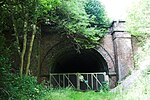North Cave is a village and civil parish in the East Riding of Yorkshire, England. It is situated 15 miles (24 km) to the west of Hull city centre on the B1230 road. South Cave is approximately 2 miles (3 km) to the south-east.
The civil parish is formed by the village of North Cave and the hamlet of Everthorpe. The 2011 UK census states that North Cave parish had a population of 1,667, a reduction on the 2001 UK census figure of 1,943. North Cave lies within the Parliamentary constituency of Haltemprice and Howden an area that mainly consists of middle class suburbs, towns and villages. The area is affluent and has one of the highest proportions of owner-occupiers in the country.Baines' History, Directory and Gazetteer of the County of York, stated that William the Conqueror gave the lordship of both North and South Cave to Jordayne, who took the surname 'Cave'. This anecdote is not supported by evidence in the Doomsday Book, however. which does not list any landholder named "Jordayne". The book identifies several lords and tenants-in-chief for both North and South Cave; beside King William himself, Robert Malet appears to be the primary landholder in 1086, but William I died in 1087, Leaving William II as successor, and so, some land may have transferred after 1086, but more evidence is required to lend credence to this family origin story.
In 1823 North Cave was a civil parish in the Wapentake of Harthill and the Liberty of St Peter's. The Metham family of Metham had at North Cave a house which had been demolished. Existing at the time was a Methodist and a Quaker chapel. Population was 783, with occupations including seven farmers, two butchers, two corn millers, four shoemakers, five shopkeepers, two tailors, two wheelwrights, a blacksmith, two butchers, a paper maker, a bricklayer, two surveyors, one for highways the other for taxes, a schoolmaster, a gardener who was also the parish clerk, and the landlords of The White Horse and Black Swan public houses. Resident were three yeomen, a surgeon, a vicar, a gentleman and two gentlewomen. A carrier operated between the village and Hull twice a week. A Hull to London coach passed through the village twice a day.The Metham family held the old North Cave Manor house and built Hotham Hall as their new residence on the same estate. The grounds of North Cave manor house were landscaped by Sir George Montgomery Metham, owner 1763–1773. The Hotham estate was sold to Robert Burton in 1773, who incorporated the grounds of the manor house into those of Hotham Hall. The Metham family retained North Cave Manor, which later passed through inheritance to the Carver family who still own the site today, part of which operates as the Williams Den adventure playground.The Quaker preacher John Richardson was born in North Cave in 1667.











